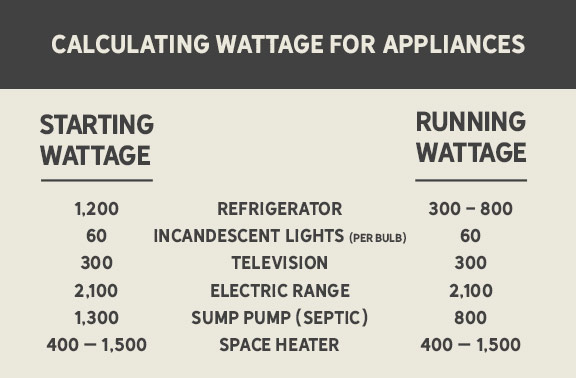

How Does a Portable Generator Work? And Safety Tips
The weather is unpredictable, but your power doesn’t have to be with a home emergency generator. Generators convert mechanical energy into electrical power, which can be used to run appliances in your home during emergencies. Let's look at portable home generators and how they work along with some safety tips before your next power outage.
Options for Portable Generators
There are many different types of generators on the market, the most popular are portable generators. This type is a great choice if you live in a warmer climate and only lose power occasionally due to a rare winter storm. It’s a great source of backup power when you only need to generate enough power to run a few essential appliances in your home like the heater and refrigerator.
Portable generators can emit from 5,000 - 7,000 watts of power. The size you’ll need is determined by the size of your home and appliances you consider most important to keep running (for example, lights, fan, portable A/C, and refrigerator). You’ll need to calculate the required running or rated wattage for the appliances you want to power, to ensure you have sufficient wattage. All appliances have a start-up or surge wattage to include, which is the wattage required for the first two to three seconds to start an appliance in your home.


Some portable generators are powered by gas or diesel, and will need to be refueled, while some are battery powered. No matter the fuel type, it’s best to have a transfer switch installed by a licensed electrician. A transfer switch safely connects a portable generator to the electrical load of your home. If your generator is over 5,000 watts a transfer switch is required for safety; however, it’s a good idea to have one for home emergency portable generators, so you can immediately plug your portable generator into the transfer switch. Extension cords without a transfer switch can be used on 5,000-watt portable generators.
Most Common Fuel Types
- Gasoline or propane portable generators are less expensive, yet the cost of gas or propane can add up over time. Some are gas-propane hybrids that give you the choice of fuel. If using gas, put fuel stabilizer in your gas containers, so the gas is stable for up to three years. Propane options will not need stabilizers. These are loud (yet quieter than diesel), have toxic emissions (if gas), and are also flammable.
- Inverter gas/propane portable generators are a smaller option if you don’t need much power and will run more quietly.
- Diesel portable generators use diesel fuel, which works better in freezing weather because of the low burning temperature. They are more fuel-efficient, and last longer than gas generators. However, they are heavier, still flammable, more expensive than gas generators, and also have toxic emissions.
- Solar portable generators are charged by the sun and use a battery power bank, are quiet, and can run indoors due to the lack of emissions. They are more expensive and can be unreliable in low sunlight. They provide less power, but some models have batteries that provide backup power.
- Natural gas portable generators run on natural gas, so you can connect them to your home’s existing supply. If your gas supply is cut off, you cannot use your generator. They have lower emissions, yet the installation and maintenance costs are more expensive.

10 Safety Tips When Using a Portable Generator

You should adhere to the highest level of safety standards when running any home generator. Each generator comes with a list of steps that must be followed to avoid injury. You want your family comfortable and safe in a power outage and want your generator ready when you need it. Here are some safety tips before you begin:
- Always run generators outdoors unless it states otherwise. Ensure your generator is at least 20 feet from your home on a level surface with a clear space of five feet around the generator. Don't place a generator in a garage as even an open garage door does not provide enough ventilation.
- Install carbon monoxide detectors in your home even though the generator will be outside. Don't let children or pets near the generator. Remember carbon monoxide is clear and odorless, so you won’t know it’s present without a detector.
- Ensure your portable generator stays dry. A canopy-type covering over the generator is ideal to protect it in inclement weather. Keep the sides of the protective structure open to provide full ventilation.
- Make sure you have the right extension cords. The power of a portable generator is determined by watts, but power cords are measured in amps. So, make sure the power of the outlets on your generator equals the power cord you use. Also make sure the cord is over 20 feet long, so you can place the generator at a safe distance from your home. Make sure you select the coordinating power cord prong shape: three-prong, four-prong, twist-lock, or straight-blade.
- Check that your power cords are in good shape each time you plug them in. This includes cuts, nicks, or frays. A cord that is damaged can cause an electric shock.
- Never back-feed your generator. This is when homeowners plug their generator into their home’s electrical panel or even a dryer outlet instead of using a professionally installed transfer switch. This is extremely dangerous and can result in fire and injuries to yourself or a power company employee.
- Turn off your generator before refueling. Turn off your generator and allow the engine to cool for at least 15 minutes, as any gas that spills on a hot engine can ignite and cause a fire. Unplug the cords before refueling your generator. After refueling, let your generator run for a couple of minutes to stabilize it, then plug everything back in using the correct steps.
- Check for gas leaks in your home after a storm before you use your generator.
- Plug the item into your generator that requires the most power first. After you plug in each appliance, let it run for a few minutes before plugging in other items. If you have a transfer switch, you will need to turn on each breaker separately to avoid a power surge.
- Perform regular maintenance on your generator. Read the owner’s manual to find out what type of oil your generator uses and how often it should be replaced. Use a stabilizer too. If your generator sits for longer than 6 months, replace unused fuel with new, stabilized fuel. You can put this unused fuel in your car.
With so much to consider, come visit us at McCoy’s to discuss which home generator is best for your home and your budget. We can help equip you with your generator, transfer switch, and power cords. Portable generators are available at McCoy’s, so come get your portable generator before the next storm, so you don’t have to be without power.

Reviewed by Noah VanDenAkker
McCoy's In-House Expert
